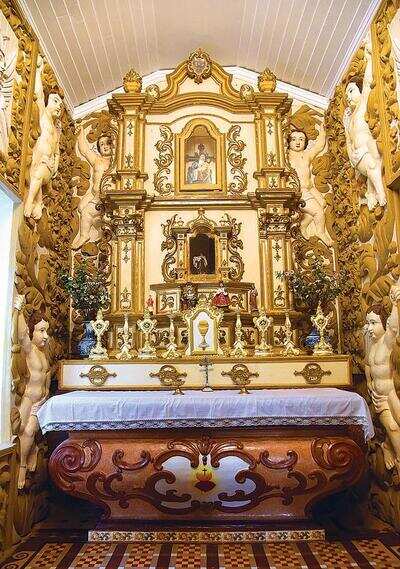Trending Topics
PRAYING IN PRIVATE

Every year, for 13 days in June, the Saldanha Osorio family of Arossim opens the door of its palatial house to the public.
From June 1 to 13, the family celebrates the Trezena to St Anthony, the patron saint of the house, joined by neighbours and villagers at their private chapel on the mezzanine floor. It is a tradition that has continued for over a century.
“The chapel is very special to the family,” says Kenneth De Saldanha Osorio, who lives there with his mother, wife, and children. “My earliest memory of it is the novena starting early in the morning and we had to rush to catch the school bus. All of us stayed at home for the feast (on June 13).”
The Saldanha Osorio house was built and occupied by the Jesuits in the early 1700s as their summer home. Expelled by the Portuguese in 1759, the Jesuits’ holdings at Arossim were confiscated and sold at an auction to bidders, which was won by two brothers, Sebastiao Joaquim Do Rosario Ozorio (captain of the Portuguese infantry) and Ignacio Caetano Piedade Do Rozario Ozorio (senator of Salcete, 1783).
Since then, the majestic chapel, among the grandest in the state, has continued to hold pride of place.
Next door is the mansion of the Pereira Andrade family. It was built later by Ignacio Caetano Piedade Do Rozario Ozorio, who demolished a section of the mansion and rebuilt a house adjoining the original one, with different architecture and elevation.
This house also boasts a private chapel of its own.
In fact, the small village of Arossim in the Mormugao taluka alone has five affluent families that have private chapels inside their mansions.
Neighbouring Cansaulim also has one, and even though the Second Vatican Council (1962-65) transformed the Church from an exclusive to an inclusive institution and stopped Masses inside most private chapels, Goa’s devotion towards chapels at home has not slowed down.
“There are a minimum of 40 private chapels inside Goan homes,” says civil engineer Alinto Coelho, who has been documenting heritage houses for the last three years and has visited almost 140 of them across the state. “Many chapels have unique idols, not found anywhere else. At the Saldanha Osorio family, St Anthony is seen cradling Child Jesus, while in most idols and images, the patron saint of lost and stolen articles is shown holding Child Jesus upright.”
The family chapel of the Fernandes House at Sernabatim is dedicated to Nossa Senhora Das Angustias (Our Lady of Sorrows) and the statue of Our Lady, says Coelho, is “very rare, not commonly seen either in private or public chapels”.
Solar dos Colacos in Ribandar has the Black Madonna of Spain while Chandor’s famous Bragança Pereira house has the relic of St Francis Xavier in the form of his fingernail. The Antao house in Betalbatim are proud owners of a relic of the cross of Jesus Christ that was given by Pope Pius VII to Fr Eugenio Xavier Antao, who then handed it over to his mother during the early 19th century.
Most private chapels, each with a different design, custom-made between the owner and the artisan, are well maintained and have celebrations once a year.
“When Goans were allowed to become priests, they were not allotted churches since there were already (Portuguese) parish priests and assistants. Mostly, the aristocrats would become priests. It would take time for them (to be allotted churches), so people built chapels at home where they could celebrate Mass,” says Fr Victor Ferrao, an independent researcher attached to the St Francis Xavier Church, Borim.
The house of Eurico Santana de Silva in Margao probably has the largest private chapel in Goa, while other popular places include Bragança Pereira (Chandor), Costas at Utorda, Quadros e Costas at Loutolim, Fernandes Mansion (Sernabatim), Cota House (Chinchinim), Antao House, Fidelis Alemao House (both Betalbatim), Noronhas at Neura, the Velhos at Benaulim and Solar dos Colacos at Ribandar.
“Besides chapels being built at home for (family) priests, there were pensoes (pensao) as well,” says Fr Nelson Sequeira, professor at the Rachol Seminary. “When people received properties, there was a commitment to celebrate Masses, sometimes 365 days a year. People would then build chapels and keep a priest who was, at that time, not engaged anywhere.”
Pensao is an obligation of certain acts, like the celebration of Masses. Non-fulfilment of these obligations, people believe, can lead to recurring illnesses or unexpected deaths.
Goa’s Liberation in 1961 after 450 years of Portuguese rule coincided with the formation of the Second Vatican Council (1962-65) that reconsidered Church practices and laid a new foundation.
Vatican II decreed that altars should be turned around, and priests face the entire community of believers, not just the clergy or Church hierarchy. More importantly, Masses inside private chapels were discontinued.
“After the Second Vatican Council, the focus was on one community where a parish becomes the body of Christ. Therefore, we could not allow a parish to be divided. The parish priest could allow Masses (inside private chapels) based on the need of the place and the pastoral situation,” says Fr Ferrao.
As the Church focused on getting the community together, the concept of private chapels started fading away. But for those who’ve prayed at home for years, the belief, whatever the circumstances, remains as strong as ever.
From June 1 to 13, the family celebrates the Trezena to St Anthony, the patron saint of the house, joined by neighbours and villagers at their private chapel on the mezzanine floor. It is a tradition that has continued for over a century.
“The chapel is very special to the family,” says Kenneth De Saldanha Osorio, who lives there with his mother, wife, and children. “My earliest memory of it is the novena starting early in the morning and we had to rush to catch the school bus. All of us stayed at home for the feast (on June 13).”
The Saldanha Osorio house was built and occupied by the Jesuits in the early 1700s as their summer home. Expelled by the Portuguese in 1759, the Jesuits’ holdings at Arossim were confiscated and sold at an auction to bidders, which was won by two brothers, Sebastiao Joaquim Do Rosario Ozorio (captain of the Portuguese infantry) and Ignacio Caetano Piedade Do Rozario Ozorio (senator of Salcete, 1783).
Since then, the majestic chapel, among the grandest in the state, has continued to hold pride of place.
Next door is the mansion of the Pereira Andrade family. It was built later by Ignacio Caetano Piedade Do Rozario Ozorio, who demolished a section of the mansion and rebuilt a house adjoining the original one, with different architecture and elevation.
This house also boasts a private chapel of its own.
In fact, the small village of Arossim in the Mormugao taluka alone has five affluent families that have private chapels inside their mansions.
Neighbouring Cansaulim also has one, and even though the Second Vatican Council (1962-65) transformed the Church from an exclusive to an inclusive institution and stopped Masses inside most private chapels, Goa’s devotion towards chapels at home has not slowed down.
“There are a minimum of 40 private chapels inside Goan homes,” says civil engineer Alinto Coelho, who has been documenting heritage houses for the last three years and has visited almost 140 of them across the state. “Many chapels have unique idols, not found anywhere else. At the Saldanha Osorio family, St Anthony is seen cradling Child Jesus, while in most idols and images, the patron saint of lost and stolen articles is shown holding Child Jesus upright.”
The family chapel of the Fernandes House at Sernabatim is dedicated to Nossa Senhora Das Angustias (Our Lady of Sorrows) and the statue of Our Lady, says Coelho, is “very rare, not commonly seen either in private or public chapels”.
Solar dos Colacos in Ribandar has the Black Madonna of Spain while Chandor’s famous Bragança Pereira house has the relic of St Francis Xavier in the form of his fingernail. The Antao house in Betalbatim are proud owners of a relic of the cross of Jesus Christ that was given by Pope Pius VII to Fr Eugenio Xavier Antao, who then handed it over to his mother during the early 19th century.
Most private chapels, each with a different design, custom-made between the owner and the artisan, are well maintained and have celebrations once a year.
“When Goans were allowed to become priests, they were not allotted churches since there were already (Portuguese) parish priests and assistants. Mostly, the aristocrats would become priests. It would take time for them (to be allotted churches), so people built chapels at home where they could celebrate Mass,” says Fr Victor Ferrao, an independent researcher attached to the St Francis Xavier Church, Borim.
The house of Eurico Santana de Silva in Margao probably has the largest private chapel in Goa, while other popular places include Bragança Pereira (Chandor), Costas at Utorda, Quadros e Costas at Loutolim, Fernandes Mansion (Sernabatim), Cota House (Chinchinim), Antao House, Fidelis Alemao House (both Betalbatim), Noronhas at Neura, the Velhos at Benaulim and Solar dos Colacos at Ribandar.
“Besides chapels being built at home for (family) priests, there were pensoes (pensao) as well,” says Fr Nelson Sequeira, professor at the Rachol Seminary. “When people received properties, there was a commitment to celebrate Masses, sometimes 365 days a year. People would then build chapels and keep a priest who was, at that time, not engaged anywhere.”
Pensao is an obligation of certain acts, like the celebration of Masses. Non-fulfilment of these obligations, people believe, can lead to recurring illnesses or unexpected deaths.
Goa’s Liberation in 1961 after 450 years of Portuguese rule coincided with the formation of the Second Vatican Council (1962-65) that reconsidered Church practices and laid a new foundation.
Vatican II decreed that altars should be turned around, and priests face the entire community of believers, not just the clergy or Church hierarchy. More importantly, Masses inside private chapels were discontinued.
“After the Second Vatican Council, the focus was on one community where a parish becomes the body of Christ. Therefore, we could not allow a parish to be divided. The parish priest could allow Masses (inside private chapels) based on the need of the place and the pastoral situation,” says Fr Ferrao.
As the Church focused on getting the community together, the concept of private chapels started fading away. But for those who’ve prayed at home for years, the belief, whatever the circumstances, remains as strong as ever.
Start a Conversation
FOLLOW US ON SOCIAL MEDIA
FacebookTwitterInstagramKOO APPYOUTUBE










